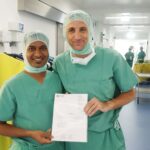MYTHS & FACTS
Myth: Sitting up straight all the time prevents back pain.
Fact: While maintaining good posture is important, sitting up straight all the time is not necessary. It’s more beneficial to alternate between different seated positions, take breaks to stretch and move, and engage in regular exercise to strengthen the back muscles.
Myth: Lifting heavy objects always leads to back pain or injury.
Fact: Lifting heavy objects can increase the risk of back injury if not done correctly. However, with proper lifting techniques, such as bending at the knees and using the leg muscles, as well as maintaining a strong core and back, it is possible to lift heavy objects without causing harm.
Myth: Bed rest is the best treatment for back pain.
Fact: While rest can be helpful during the acute phase of back pain, prolonged bed rest is generally not recommended. It can lead to muscle stiffness and weakness, and delay recovery. Staying active, engaging in gentle exercises, and gradually increasing activity levels are often more beneficial for relieving back pain and promoting healing.
Myth: Surgery is the only solution for spinal problems.
Fact: Surgery is not always the first or only treatment option for spinal problems. In many cases, conservative treatments such as physical therapy, medication, exercise, and lifestyle modifications can effectively manage spinal conditions. Surgery is typically considered when conservative treatments fail or when there is a severe spinal condition that requires intervention.
Myth: Crunches and sit-ups are the best exercises for a strong core.
Fact: While crunches and sit-ups can help strengthen the abdominal muscles, they can also place strain on the spine, particularly if performed with poor form. There are other exercises, such as planks, bridges, and yoga poses, that can effectively strengthen the core without excessive strain on the spine.
Myth: Back pain is always caused by a spinal problem.
Fact: Back pain can be caused by a variety of factors, including muscle strain, poor posture, arthritis, and other conditions. Only a medical evaluation can determine the cause of back pain.
Myth: Lifting heavy objects is always bad for your back.
Fact: Lifting heavy objects is not necessarily bad for your back, as long as you use proper technique. Bending at the knees, keeping the back straight, and using your legs to lift can help prevent injury.
Myth: Spinal surgery is always necessary to relieve back pain.
Fact: While surgery may be necessary in some cases, many people can find relief from back pain through non-surgical treatments such as physical therapy, medication, and lifestyle changes.
Myth: Back pain is a normal part of aging.
Fact: While back pain is more common in older adults, it is not a normal part of aging. Many seniors can maintain good spinal health through exercise, healthy habits, and regular medical care.
Myth: Spinal manipulation by a chiropractor is always safe and effective.
Fact: While spinal manipulation can be an effective treatment for certain conditions, it is not appropriate for everyone. Chiropractic treatment carries some risks, and it is important to choose a qualified and experienced practitioner.
Myth: Spinal problems are always visible on X-rays or other imaging tests.
Fact: Not all spinal problems are visible on imaging tests. In some cases, a medical evaluation and physical exam are necessary to diagnose spinal conditions.
Myth: Spine surgery is always the last resort and should be avoided if possible.
Fact: While conservative treatments are typically attempted first, spine surgery is not always a last resort. In some cases, surgery may be the most effective and appropriate treatment option to address certain spinal conditions or alleviate severe symptoms.
Myth: Spine surgery is always risky and has a high chance of complications.
Fact: Like any surgical procedure, spine surgery carries certain risks and potential complications. However, advancements in surgical techniques, technologies, and anaesthesia have significantly improved the safety and success rates of spine surgeries. The risks and benefits should be carefully evaluated by the surgeon on an individual basis.
Myth: Spine surgery is always very painful and requires a long recovery period.
Fact: Pain and recovery experiences can vary depending on the type and complexity of the spine surgery performed. Minimally invasive techniques such as endoscopic spine surgery
have been developed that often result in smaller incisions, less tissue disruption, and shorter recovery times compared to traditional open surgeries. Pain management strategies are also utilized to help control postoperative discomfort
Myth: Once you have spine surgery, you'll always need additional surgeries in the future.
Fact: While some spinal conditions may require additional surgeries or ongoing interventions, it is not the case for all patients. Successful spine surgery, combined with appropriate postoperative care and lifestyle modifications, can lead to long-lasting pain relief and improved function without the need for further surgical interventions.
Myth: Exercise and physical activity are harmful to the spine.
Fact: Regular exercise and physical activity are generally beneficial for the spine. Strengthening the muscles that support the spine, improving flexibility, and maintaining a healthy weight can help prevent spine-related problems and promote overall spine health. However, it’s important to engage in exercises with proper form and technique and avoid activities that put excessive strain on the spine.
Myth: Sleeping on a firm mattress is always best for the spine.
Fact: The ideal mattress firmness varies depending on personal preference and individual needs. While some people find a firm mattress supportive for their spine, others may prefer a medium or softer mattress for comfort. It’s important to choose a mattress that provides adequate support and alignment for your spine while also considering your own comfort level.
Myth: Only older adults need to be concerned about spine health.
Fact: Spine health is important at all stages of life. Taking proactive measures to maintain a healthy spine, such as practicing good posture, engaging in regular exercise, and avoiding excessive strain or injury, can benefit individuals of all ages and help prevent spine-related problems later in life.







